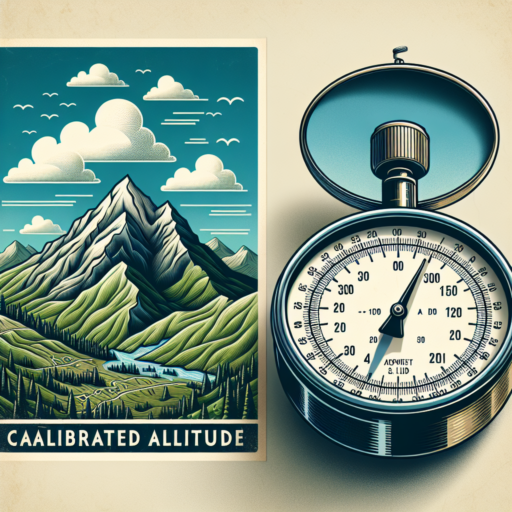What is true altitude and calibrated altitude?
Understanding the nuances between true altitude and calibrated altitude is crucial for both seasoned aviators and aviation enthusiasts. While they might seem interchangeable, each term describes a specific way of measuring an aircraft’s height, essential for safe and precise navigation.
True altitude refers to the actual height of an aircraft above mean sea level (MSL). It is considered the most accurate measurement of altitude, primarily used for ensuring compliance with aviation regulations and for navigational purposes. Pilots and air traffic controllers rely on true altitude to avoid terrain and obstacles, and to maintain safe vertical separation between aircraft.
Calibrated altitude, on the other hand, is the altitude corrected for instrumental errors and discrepancies. It’s derived from the aircraft’s pressure altimeter setting, adjusted to local air pressure conditions. This adjustment is vital for accurate altitude measurements, especially in varying weather conditions and changing atmospheric pressures.
Both true and calibrated altitudes play pivotal roles in aviation safety and efficiency. While true altitude provides an absolute measure above sea level, calibrated altitude ensures that all aircraft in the vicinity report altitude figures that are consistent with each other, minimizing the risk of mid-air collisions and ensuring a safer airspace for all.
What is the difference between calibrated altitude and GPS altitude?
Understanding Calibrated Altitude vs. GPS Altitude
When delving into the realm of aviation or geolocation technologies, one often encounters two key terms: calibrated altitude and GPS altitude. Though both relate to measuring height or altitude, their sources and the principles behind their determination set them apart significantly. Calibrated altitude is derived from atmospheric pressure readings and adjusts for variations in air pressure, whereas GPS altitude is obtained directly from signals received from a network of satellites orbiting the Earth.
Calibrated altitude, often used in the aviation industry, is gleaned from barometric altimeters. These devices measure the pressure of the atmosphere and, using standard calculations, convert these readings into an altitude figure. This measurement is crucial for air navigation as it reflects the aircraft’s height above mean sea level using atmospheric pressure data, which can be influenced by weather conditions and temperature. However, it necessitates regular adjustments or calibration against a known sea-level pressure, to maintain accuracy.
On the other hand, GPS altitude comes from the Global Positioning System (GPS), a technology that calculates positions based on signals from satellites. This altitude is a measure of one’s height above the Earth’s ellipsoid, a mathematical model that approximates the shape of the Earth. GPS altitude can be more universally applicable, taking advantage of a global network of satellites to provide altitude information. It is often appreciated for its ability to function without the need for local air pressure data, making it advantageous in various applications outside of aviation, including hiking, mountaineering, and other GPS-based activities.
What are the four types of altitude?
Understanding the concept of altitude is critical for various fields, particularly in aviation, where it is essential for ensuring safe and efficient flight operations. Altitude, in its most basic definition, refers to the height of an object relative to a specific reference point. This concept is multifaceted, encompassing four primary types that are pivotal for pilots, air traffic controllers, and aviation engineers alike. These types include Indicated Altitude, Absolute Altitude, True Altitude, and Pressure Altitude. Each serves a unique purpose and is measured in distinct ways, reflecting the diverse operational and navigational needs within the aviation industry.
Indicated Altitude
Indicated Altitude is what pilots first encounter, as it is directly displayed on the altimeter in the cockpit. This type of altitude is measured against a standard pressure setting, making it the most straightforward yet essential reading for in-flight adjustments and ensuring adherence to flight plans. However, it’s important to note that Indicated Altitude can be influenced by changes in atmospheric pressure, requiring pilots to make calibrations based on updated weather information.
Absolute Altitude
In contrast, Absolute Altitude is defined as the vertical distance between an aircraft and the ground directly below it. This type of altitude is crucial for low-flying operations, such as agricultural spraying or helicopter missions, where proximity to obstacles on the ground poses a significant risk. Pilots rely on radar and other ground-proximity measurement tools to accurately determine their Absolute Altitude, ensuring safe navigation over varied terrain.
True Altitude and Pressure Altitude
True Altitude refers to the actual height above mean sea level (MSL), offering a precise measurement that is especially useful for creating flight charts and planning long-distance routes. Recognizing the importance of True Altitude, pilots adjust their flight level in accordance with atmospheric conditions to maintain safety and efficiency. Similarly, Pressure Altitude is used as a baseline for determining aircraft performance. Calculated as the height above a standard datum plane (usually at 29.92 inches of mercury), Pressure Altitude is a critical factor in assessing an aircraft’s aerodynamic capabilities and optimizing its flight path.
No se han encontrado productos.
What is calibrated altitude in flight radar 24?
In the landscape of aviation tracking technologies, FlightRadar24 stands out as a premier tool for both aviation professionals and enthusiasts. When exploring the myriad of data presented by this platform, one term that frequently catches the eye is calibrated altitude. Understanding what calibrated altitude signifies can greatly enhance the user experience and comprehension of flight data. Essentially, calibrated altitude is a measure that has been corrected for installation and instrument errors, offering a more precise altitude reading of an aircraft.
At its core, calibrated altitude aims to provide a more accurate representation of an aircraft’s position relative to sea level. This is pivotal as it aids in enhancing the safety and efficiency of air navigation. In the context of FlightRadar24, calibrated altitude data is meticulously derived, ensuring that users have access to information that closely mirrors the true altitude of airplanes during their trajectories. This precision is crucial for various analytical purposes, from flight tracking to air traffic management and research.
The significance of calibrated altitude in FlightRadar24 cannot be overstated. By utilizing advanced algorithms and correction methods, FlightRadar24 ensures that altitude data are not merely raw figures but refined measurements that account for atmospheric conditions and instrumental inaccuracies. This level of detail supports a wide array of applications, from flight planning to airspace monitoring, making calibrated altitude a key piece of the puzzle in understanding the complex dynamics of aerial navigation.




